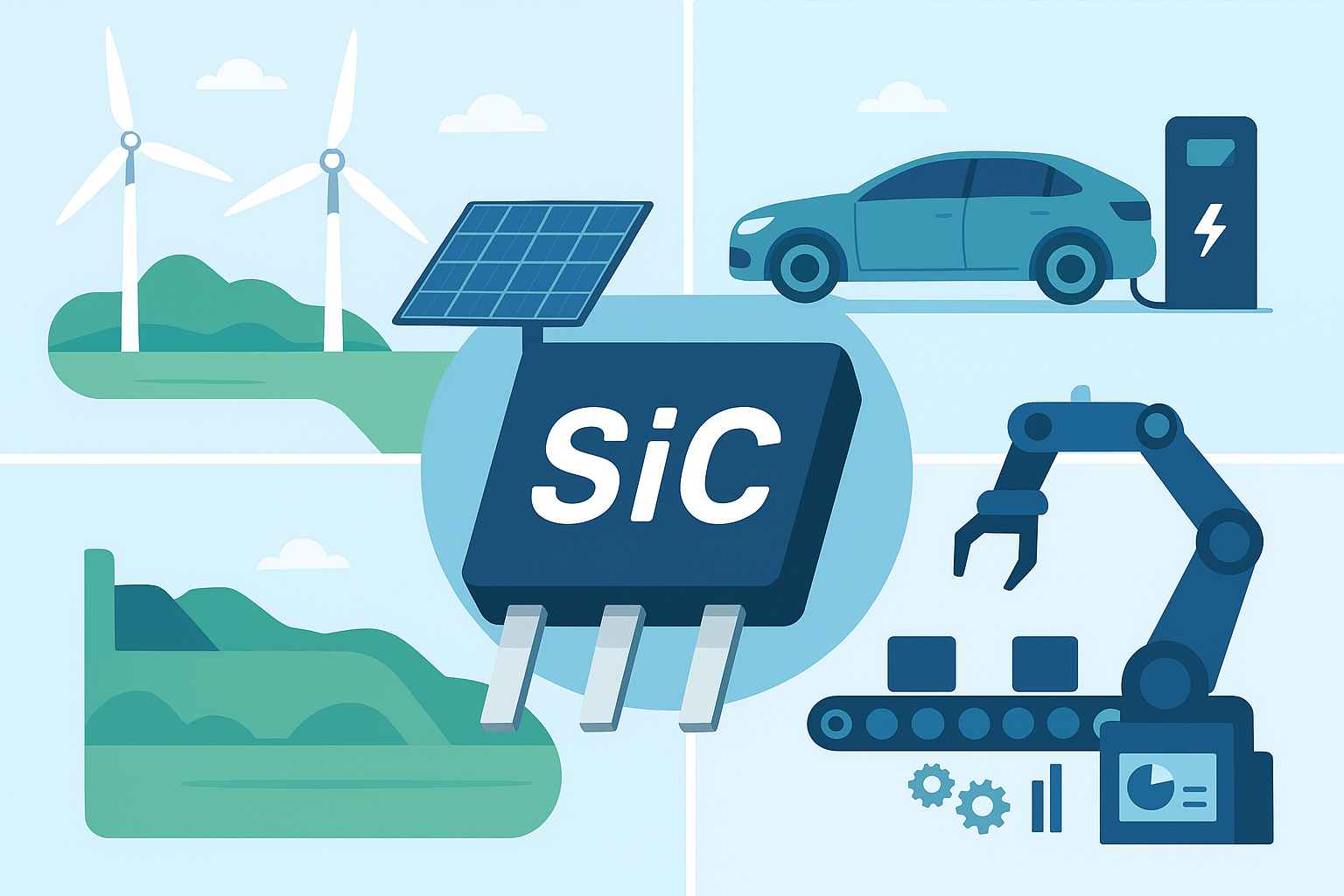Electrification is reshaping the global energy landscape, paving the way for cleaner, more sustainable systems. At the heart of this transformation is silicon carbide (SiC) power electronics, a breakthrough technology offering major advantages over conventional silicon (Si). As a wide bandgap (WBG) semiconductor, SiC delivers higher efficiency, durability, and performance, making it essential for electric vehicles (EVs), renewable energy systems, and industrial automation.

Why Silicon Carbide Outperforms Silicon
The key to SiC’s superior performance lies in its material properties. Unlike silicon’s 1.12 eV bandgap, SiC boasts a wide bandgap of 3.26 eV, enabling devices to:
- Operate at higher voltages, temperatures, and frequencies
- Provide better thermal conductivity for improved heat dissipation
- Achieve lower switching and conduction losses in MOSFETs and diodes
- Reduce the need for bulky cooling systems and heat sinks
These benefits translate into more compact, energy-efficient designs, lower operating costs, and longer system lifespans.
SiC in Transportation: Powering Efficient Electric Vehicles
In the race toward sustainable mobility, SiC power electronics are transforming electric vehicle powertrains. They are widely used in:
- Traction inverters
- On-board chargers (OBCs)
- DC-DC converters
Replacing a silicon-based 400V inverter with an 800V SiC inverter improves power density and system efficiency, while also reducing energy losses. The result?
- Extended driving ranges
- Faster charging times
- Simplified thermal design
- Lighter, more compact systems
SiC’s high-frequency switching also reduces the size of inductors and capacitors, lowering weight and cost while enhancing overall EV performance.
Industrial and Renewable Energy Applications
Beyond automotive, SiC is revolutionizing industrial systems and renewable power generation.
Renewable Energy Systems
In solar photovoltaic (PV) applications, SiC inverters offer:
- Smaller, more efficient form factors
- Placement closer to solar arrays, reducing power losses
- Simplified overall system architecture
For energy storage and grid-tied applications, SiC converters enable:
- Faster and more reliable switching
- Bidirectional power flow for smart grids
- Lower cooling requirements and operating costs
Industrial Automation
In factories and industrial plants, SiC improves motor drives and variable-speed systems by:
- Increasing efficiency
- Reducing downtime
- Enhancing energy savings in high-demand operations
Isolated Power Solutions for Harsh Industrial Environments
For programmable logic controllers (PLCs) and low-power industrial electronics, isolated power converters are essential for reliability and safety. They help:
- Eliminate ground loops
- Prevent channel-to-channel interference
- Ensure electrical isolation in tough environments
The Texas Instruments SN6507 exemplifies this design approach. It’s a compact, high-frequency push-pull transformer driver with integrated safety features such as:
- Over-current protection (OCP)
- Over-voltage and under-voltage lockout (OVLO/UVLO)
- Thermal shutdown (TSD)
- Programmable soft start for reduced inrush currents
Additionally, with spread spectrum clocking (SSC) and slew rate control (SRC), it meets ultra-low EMI requirements.
Paired with Würth Elektronik’s WE-PPTI Push-Pull Transformers, these solutions provide:
- 2.5kV isolation voltage
- Wide 120 kHz – 480 kHz frequency range
- Reliable performance across motor drives, medical devices, communication interfaces, solar inverters, and automation systems
For design testing, the SN6507 Development Kit enables engineers to evaluate multiple transformer configurations, supporting applications from renewable energy to industrial control.
Challenges and Future Outlook
Despite its promise, SiC adoption faces challenges—primarily manufacturing complexity and cost. Producing high-quality SiC wafers requires advanced crystal growth methods and specialized fabrication, making it more expensive than silicon.
However, rapid progress in wafer production, device fabrication, and supply chain scaling is steadily driving down costs. As yields improve, SiC devices will become increasingly affordable for mass-market applications.
The Path to a Sustainable Electrified Future
From EV drivetrains to solar inverters and industrial motor drives, SiC technology is accelerating the global shift toward electrification. Its unique combination of efficiency, compact design, and high performance makes it a cornerstone of the energy transition.
As production expands and costs continue to decline, silicon carbide power electronics will play a critical role in building a cleaner, smarter, and more energy-efficient world.